The Ultimate Guide: How to Use Google Trends for Dropshipping
I'm looking for...
Curious how Google Trends For Dropshipping can skyrocket your business?
This guide will take you through everything you need to know to stay ahead of market trends and make informed decisions.
From finding the hottest products to targeting the right regions, we’ll show you how to leverage Google Trends like a pro.
Ready to gain a competitive edge in your dropshipping journey? Dive in and discover the secrets!
Create Your Online Store in just 5 Minutes – For Free
Pick your niche, our AI builds your store, add 10 winning products and we teach you how start selling today. Start picking your niche
The Definition – What Is Google Trends?
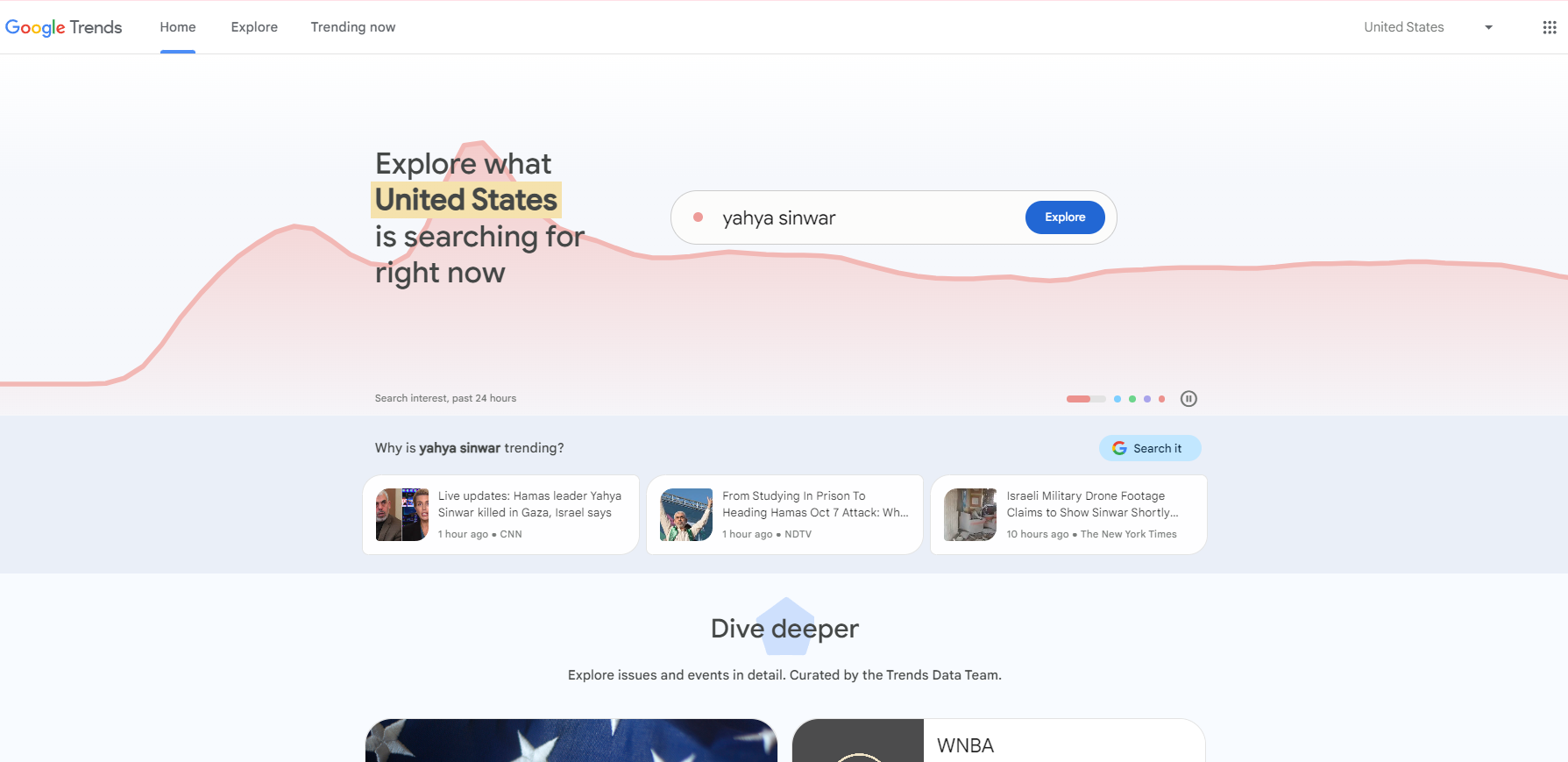
Offered by Google, Google Trends is an awesome tool that provides short- and long-term insight into what people from all over the world are searching on Google. In other words, it helps you find out what people are curious about.
As what people are searching for opens a telling window into what they are interested in and want to buy, Google Trends can be used within various fields, including e-commerce and dropshipping.
Fortunately, this tool is potent, highly versatile, and FREE. Thus, it is a must-have for any dropshipper like yourself trying to understand the market, identify a dropshipping niche, and find the best dropshipping products to sell.
In a nutshell, it may help your dropshipping business achieve its big dreams, without breaking the bank. But if you do not know how to use Google Trends for dropshipping, scroll down for more information on the topic.

How Do Google Trends Work?
As I have already said, before teaching you how to use Google Trends for dropshipping, I want to help you understand how Google Trends works as a tool for analyzing search volume and consumer interest over time.
So, here are the main elements/features of Google Trends:
1. Interest over time
Google Trends records how interest in a topic has changed and shows it to you in graph form.
Google Trends works by recording and displaying how interest in a topic has changed over a given period, providing valuable insights for business strategies like dropshipping.
This is the most important element of this tool: Tracking search interest over a given period of time.
Thus, you should enter a search term into the search box at the top of the tool to find out how the search volume has varied for that term over time.
So, let’s try it out for my coffee dropshipping business. And, let’s take a look at the graph produced by the search term “Coffee”.
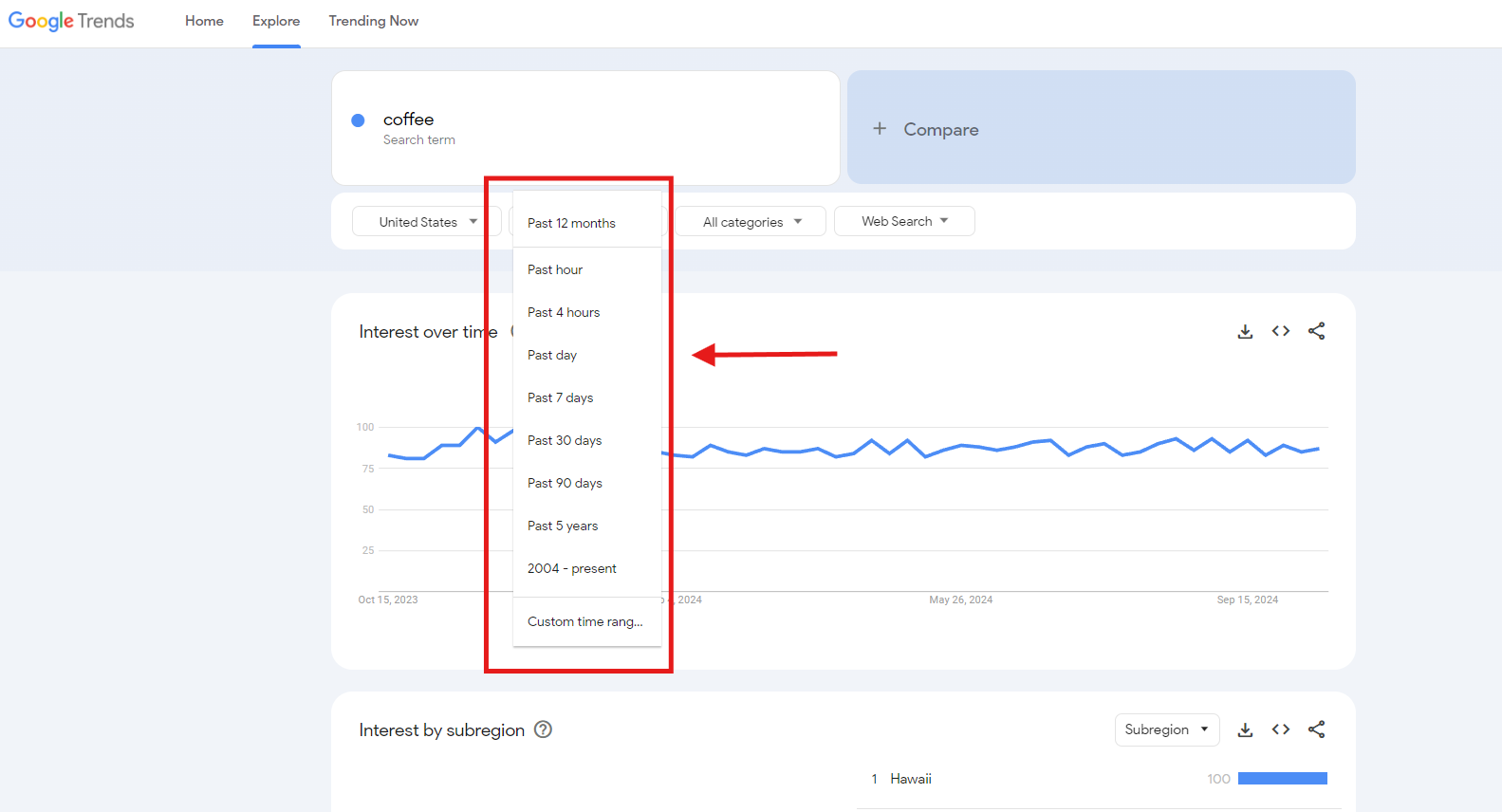
As you can see, Google Trends tells you how interest in the search term “Coffee” has changed over time. You can change the time frame, including the “past hour”, “past 7 days”, “past 12 months”, “past 5 years”, etc.
2. Interest by region
If you want to learn how to use Google Trends for dropshipping, you must also understand that this tool shows you how search interest varies by location. Google Trends works by displaying search interest data for different regions, helping businesses understand where their products might be in demand.
Thus, you can see search data for different countries or even some larger cities.
Now, let’s take a closer look at the map showing areas where the search term “Coffee” is the most popular.
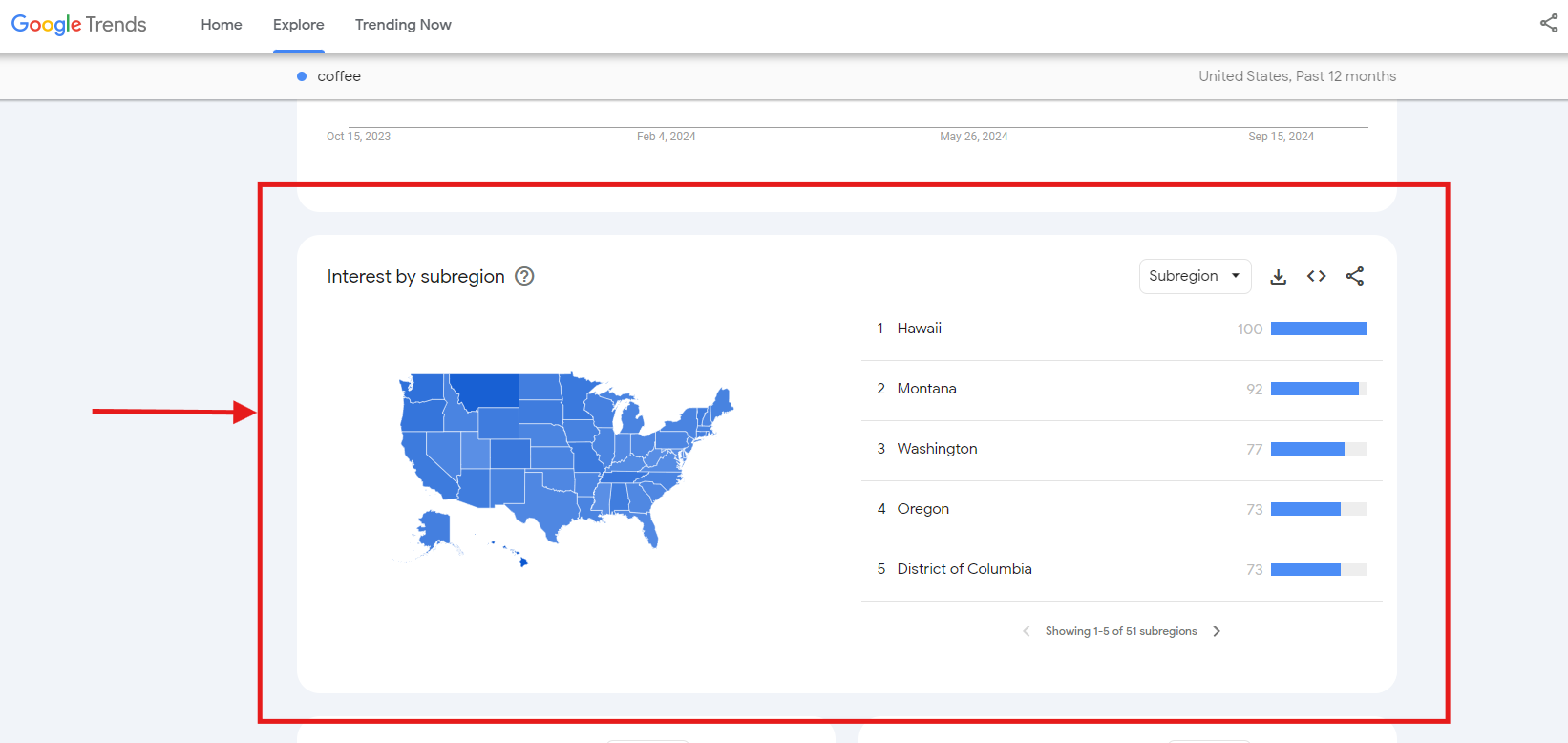
But what does this mean to you as a dropshipper? Well, the graph above helps you understand the specific areas/countries where the search interest for “Coffee” is the highest.
This can be beneficial if you want to market your products to customers in a certain area. However, I will explore this topic more deeply later in this article.
3. Related topics and related queries
Related topics and related queries can give you some ideas for dropshipping niches, products, and brands. Google Trends works by identifying related topics and queries that users search for, offering deeper insights into consumer interests.
The first option, i.e., the Related Topics, can help you find out what related topics people, who searched for your search term, may also be interested in.
However, the second option, i.e., the Related Queries, can give you some insight into what specific search terms or phrases people used when they searched for your term.

How To Use Google Trends For Dropshipping?
Understanding how Google Trends works is crucial for leveraging its data to make informed decisions in your dropshipping business. In essence, this tool enables you to better understand what people are interested in and curious about, in real-time. But you can utilize this information to do the following things for your dropshipping business:
1. Identify a Dropshipping Niche
One of the first and most important steps in starting a dropshipping business is picking a niche.
So, of course, you can run a general dropshipping store and sell products across many different categories. However, focusing on a single dropshipping niche lets you focus on a specific audience.
Thus, this way you can offer the best products that will entice your potential customers.
Selecting a dropshipping niche can be a tricky process. But with Google Trends, you can check the popularity of a specific dropshipping niche.
So, simply put, with it, you can see whether people are searching for products in that specific niche or category.
Let us give an example to illustrate my point. Then, I will do a little research for my women’s clothing store. Thus, I can check on results for interest over the past 12 months for these products.

Moreover, I can set the filters so the data will show that there has been a healthy amount of search interest globally for the niche “women’s clothing” over the last 5 years. This may be a good indicator that this is a profitable dropshipping niche.
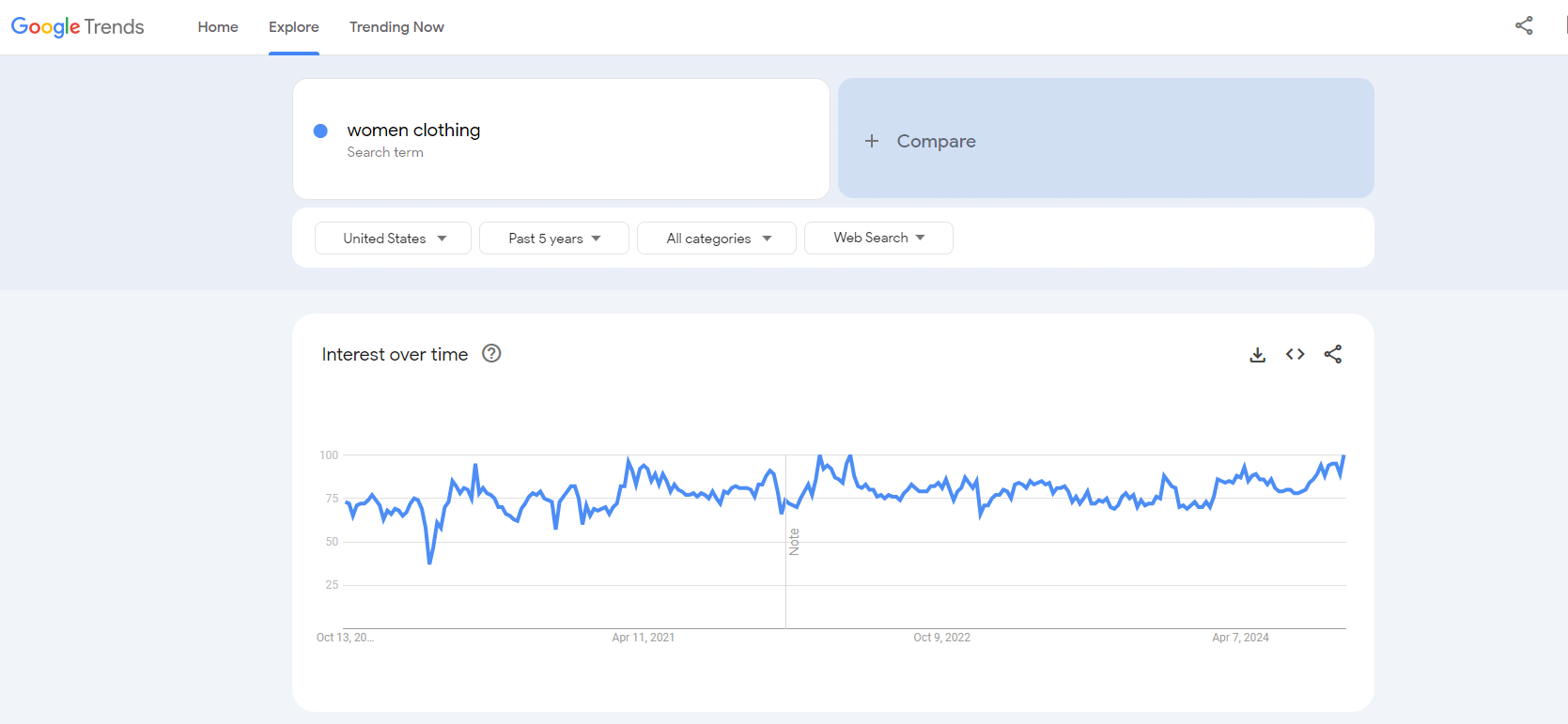
Now, let’s make a comparison between the niche “women’s clothing” and the niche “kids’ clothing” just to see which one is more popular.
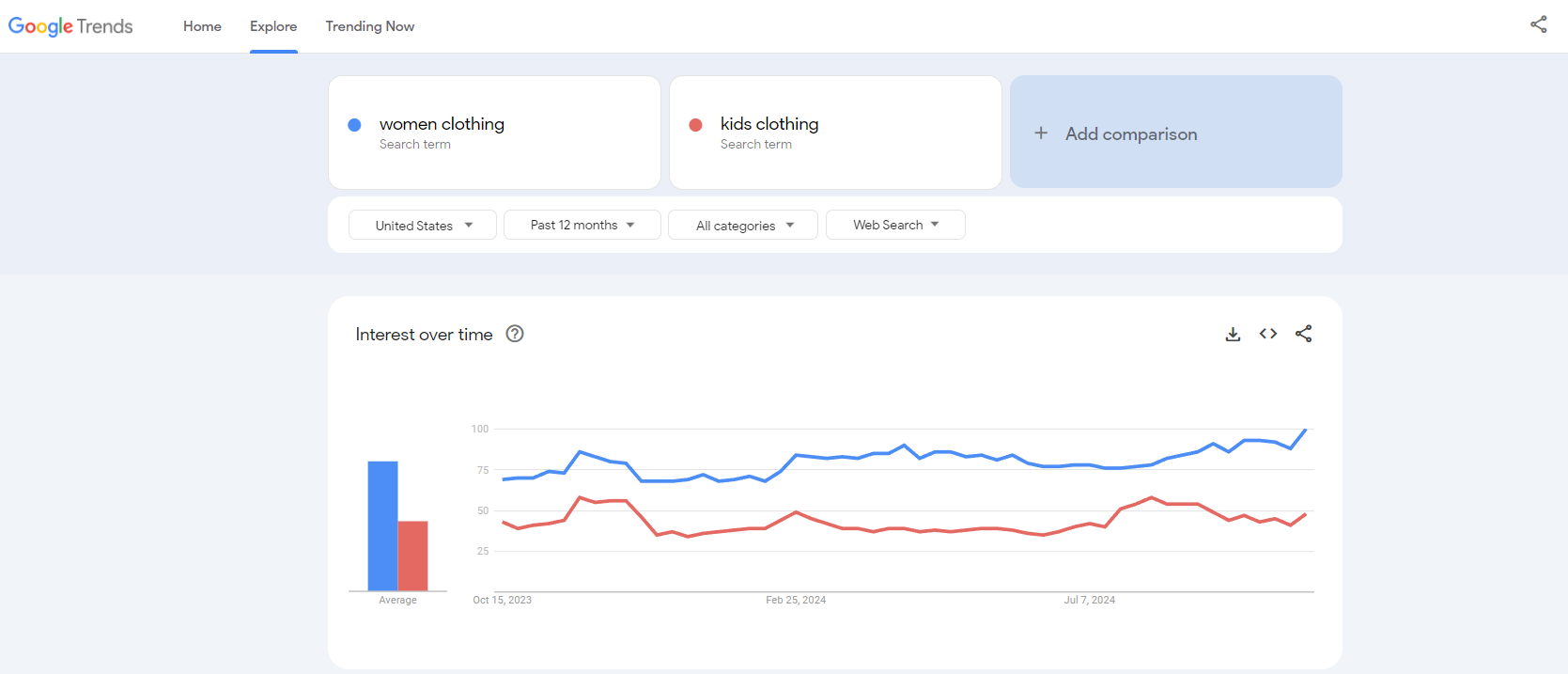
As is evident from the graph above, the “women’s clothing” niche is a bit more popular than the “kids’ clothing” one.
Practical tips on how to use Google Trends for dropshipping:
- Start quite broad and use the filter “All Categories” to extract a topic for further exploration.
- Do a general search with an umbrella keyword that pertains to the industry you, as a dropshipper, are interested in.
- Once you have analyzed your keyword, use the comparison filter to make a comparison between two or more keywords.
2. Find the Best Products to Sell
Finding the best products for dropshipping with Google Trends is also possible.
Product research is incredibly important for your dropshipping business. Finding the right products to sell can take too much time. Also, not to mention the fact that most of the dropshipping product research tools have to be paid for.
Fortunately, Google Trends is a 100% free tool for finding trending products to sell online and spotting seasonal trends.
Let’s say that you are looking to enter the women’s fashion market in the US. Thus, let’s examine the popularity of sleeveless dresses by using Google Trends.
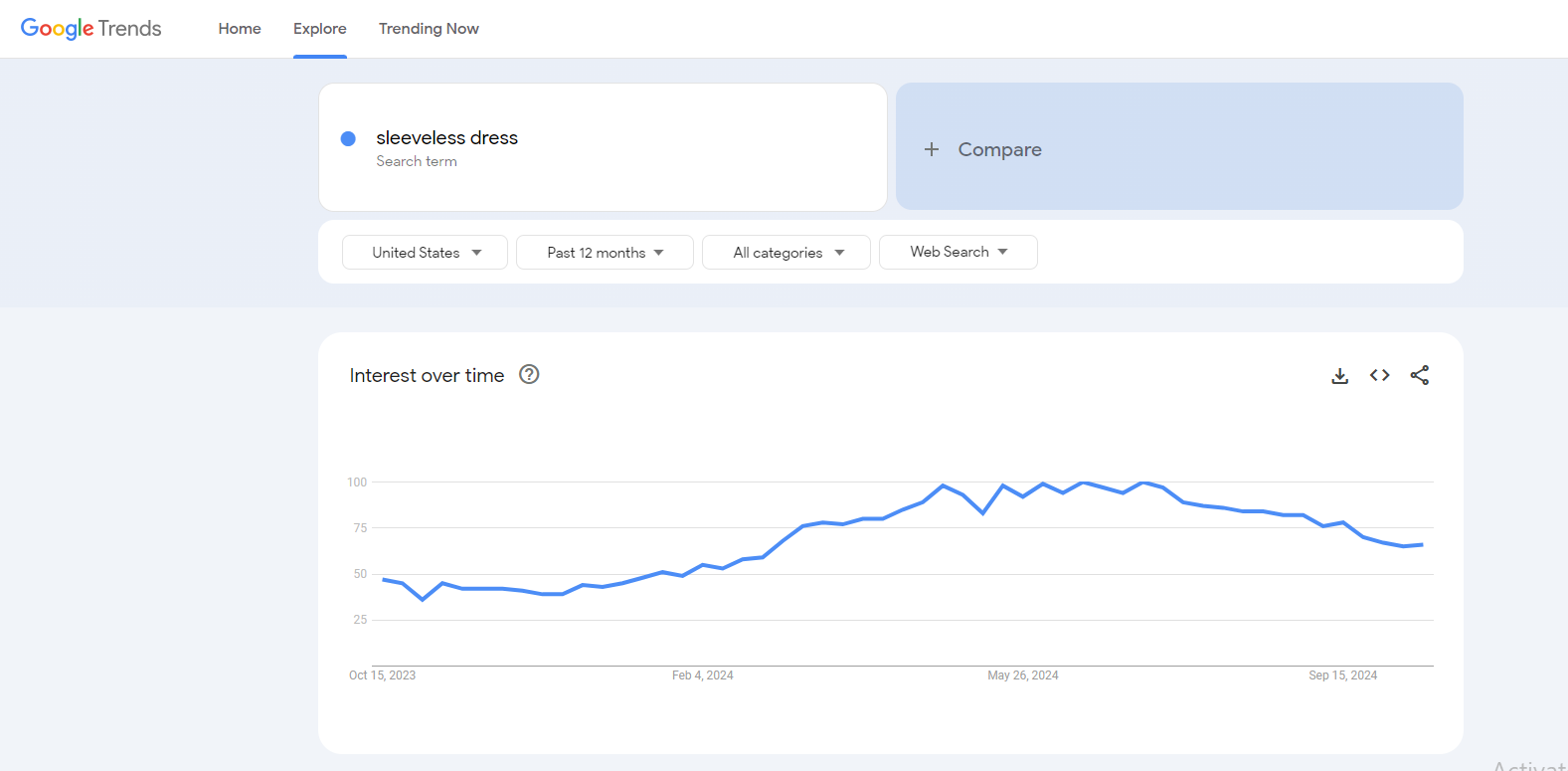
As you can see, if you choose to sell sleeveless dresses through your dropshipping store, you are likely to deal with seasonal demands.
Why? Because the demand for this product is higher during the summer months, like May, June, and July.
Learn more: Top 15 Hot Summer Products To Sell This Season.
Practical tips on how to use Google Trends for dropshipping:
- Examine search volumes for a specific product within a defined time frame and in a specific country. These filters can help you clearly see whether the search volume is increasing or declining in a particular region within a defined time frame.
- Do not forget to pay attention to seasonal spikes and take advantage of them. You may need alternative products in the “drought” months.
- Use the “Related Topics” feature mentioned above. That way, you can find amazing product suggestions and expand your product offerings.
Interested in using other free methods to find what to sell online? Here are 5 free ways to find winning dropshipping products.
3. Finding Suppliers For Your Business with Google Trends
Once you’ve nailed down your best-sellers, the next step is finding reliable suppliers. One way to do that is to use Google Trends for more than just products—you can also leverage Google Trends data to find trending keywords and suppliers that are relevant to your online store.
By entering search terms related to suppliers into the Google Trends search bar, you can explore how they rank over time. This helps you understand their visibility and whether they’re trusted within your target audience.
For example, let’s compare AutoDS and Zendrop. The Google Trends data shows that both platforms higher search interest, meaning it has a stronger presence in related queries.

This suggests that Zendrop might be more trusted or popular than AutoDS in certain regions, while AutoDS in another regions. Understanding this can help you make informed decisions about which supplier to work with, especially if you’re looking to cater to a specific target audience.
Another powerful feature of Google Trends is the ability to compare related topics and see regional trends. You can also discover how suppliers perform in specific areas by analyzing Google search data or by breaking down the search queries regionally.
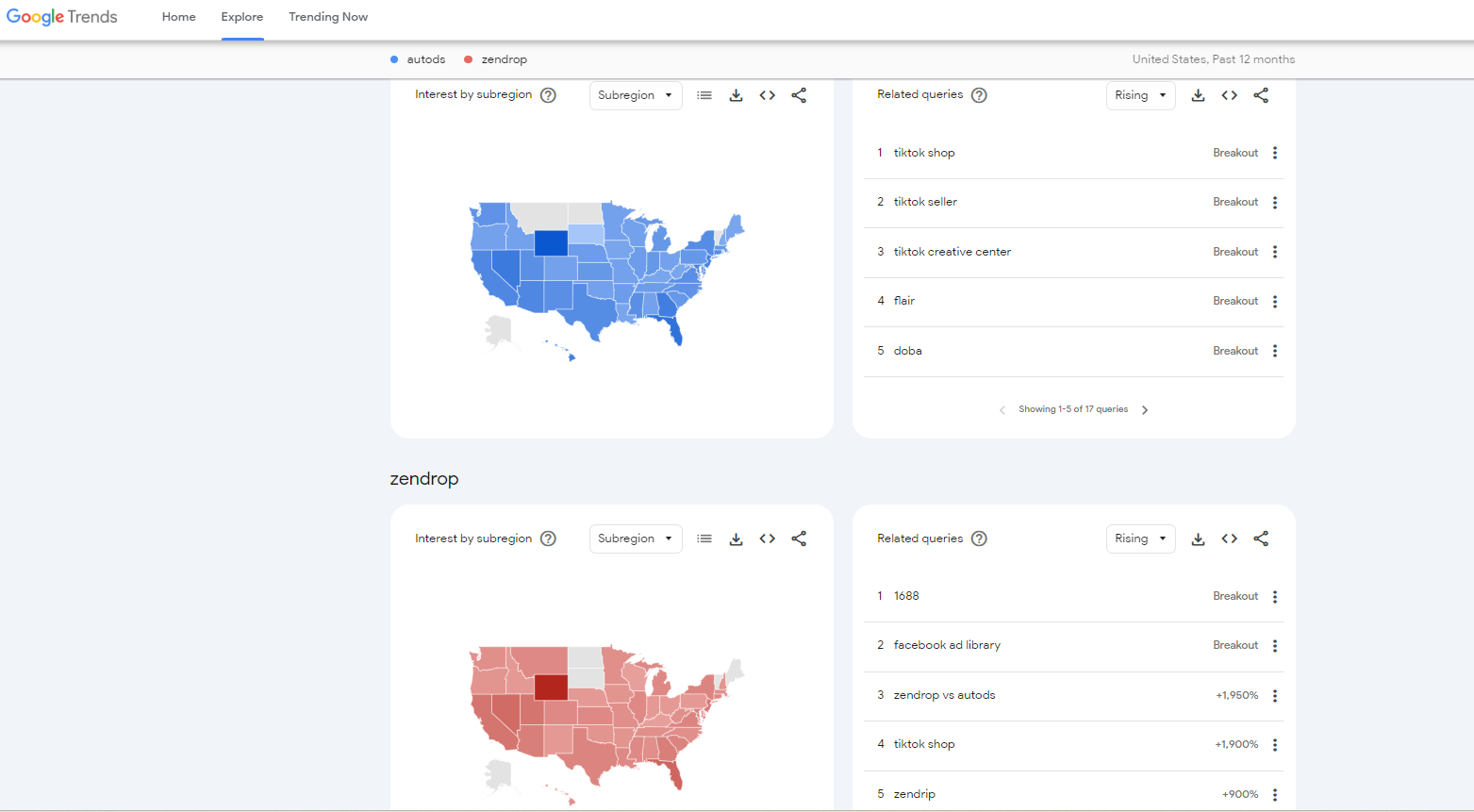
Thus, this is especially helpful for refining your keyword search and targeting specific related keywords based on search engine optimization (SEO) strategies.
By using Google Trends dropshipping, you can uncover valuable insights about supplier performance and even see which suppliers are in high demand. Not only does this enhance your marketing efforts, but it also improves your overall business model by ensuring that your customers receive their orders from reliable suppliers.
4. Target a Certain Country When Promoting Your Dropshipping Business
It is as clear as day that dropshipping stores are operated online. This means that your customers can be based anywhere in the world (if your dropshipping suppliers are willing to ship there, of course.)
But just because you can have global customers doesn’t mean that you do not have to assess the regional trends for your niche or product.
By using Google Trends, you can do so and understand where (in which countries) there is a huge spike in searches for your product.
That way, you can find a new market for your product and focus on that market when promoting your business.
Let’s go back to our “sleeveless dress” example and see what the world thinks about sleeveless dresses.
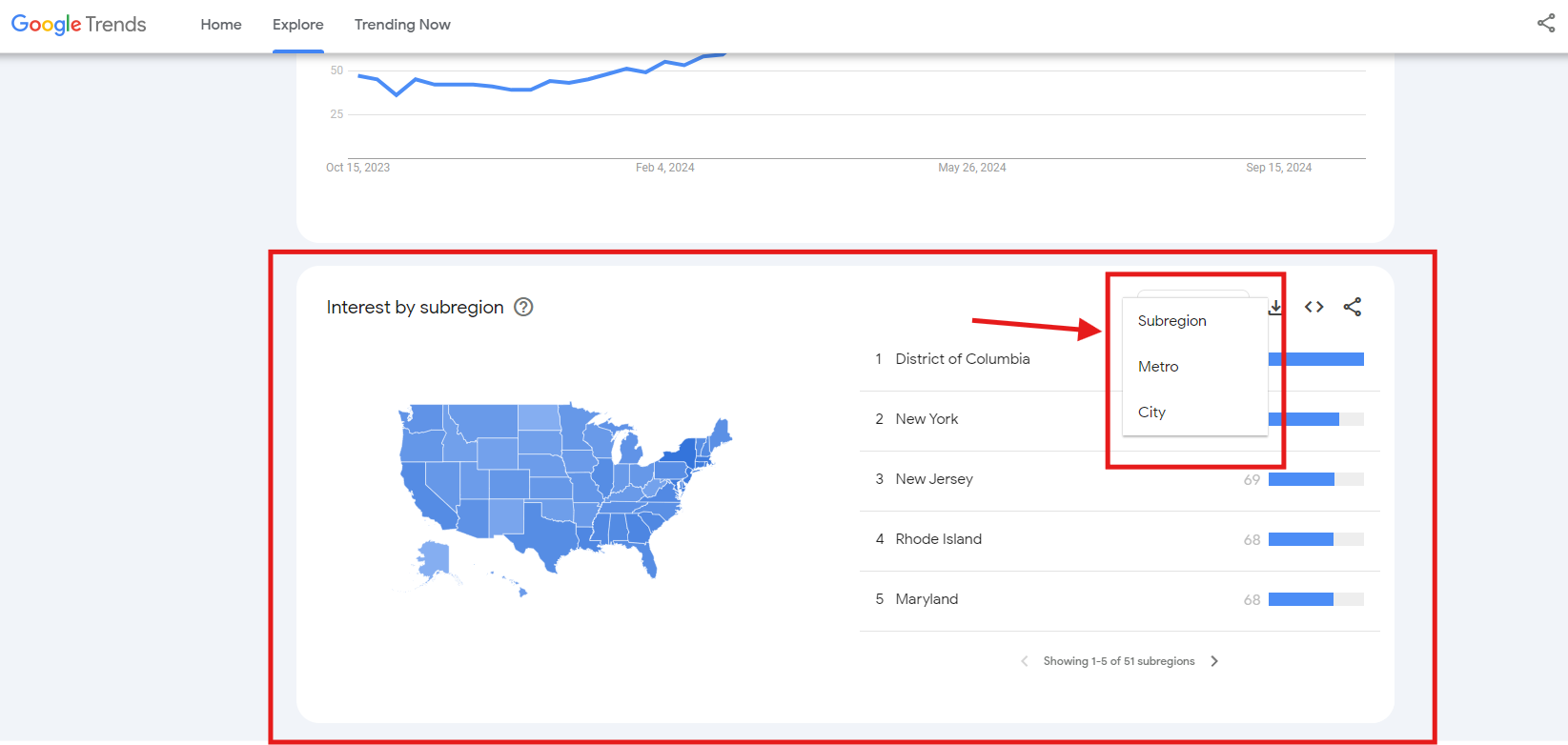
According to my search results, Columbia, New York, New Jersey, and Maryland, to name a few, are the counties with the highest volume of searches for sleeveless dresses.
Practical tips on how to use Google Trends for dropshipping:
- Just click on a region to get more details on the search volume in that region. This allows you to see a list of subregions or even cities ranked based on the popularity of your search term.
5. Improve your SEO and content marketing strategies
You should also learn how to use Google Trends for your dropshipping business to improve your SEO, and content marketing strategies. This will ultimately drive traffic to your site.
Namely, keyword search volume refers to how many times people typed a term into the search box of Google within a set time frame.
But why does this matter?
Well, with Google Trends, you can enter a keyword phrase and check its popularity. And, if the relevant keyword has a high search volume, you may consider adding it to your product description or a blog post.
As a dropshipper, you want the keywords on your site to be relevant to what people are searching for so they are more likely to find your product and content among Google search results.
Take the term “lipsticks”, for example. According to Google Trends, the search volume for the term “lipstick” is trending upward, which means that it may be a good product to sell.
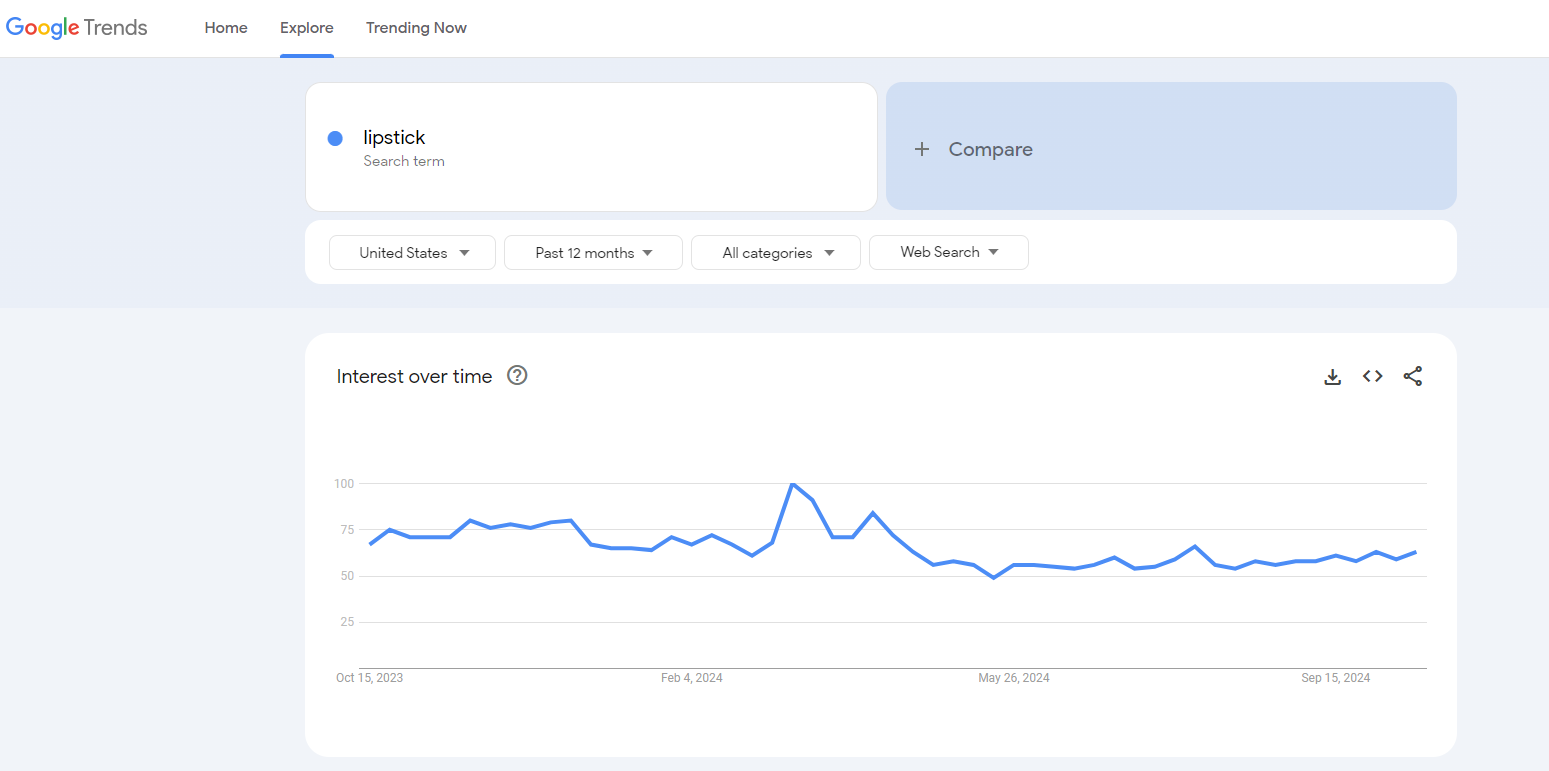
But you need to find the keywords that go with this query. Using Google Trends, scroll down to see the “Related Topics” and “Related Queries” to optimize the use of related keywords.
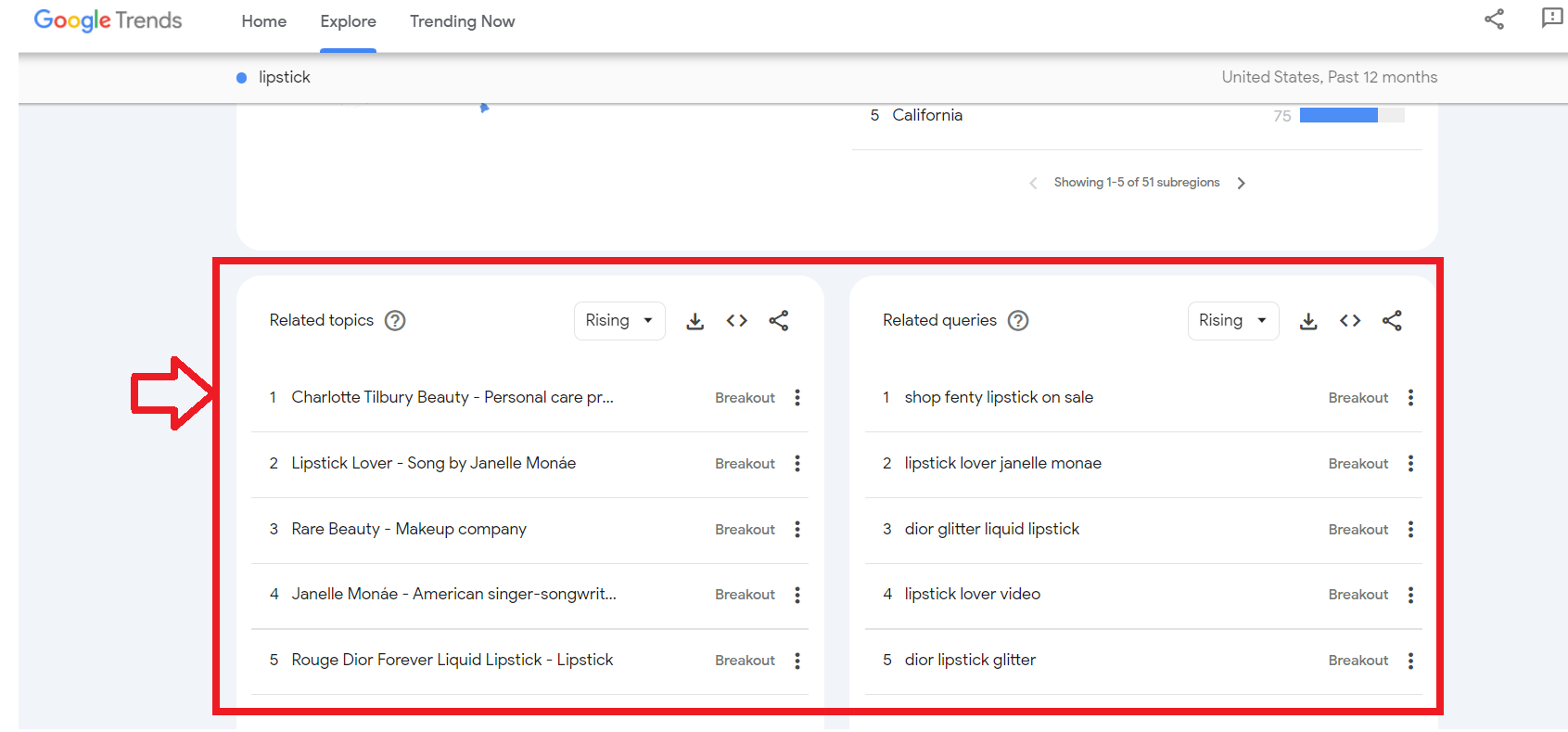
Practical tips on how to use Google Trends for dropshipping:
- Compare the search volume for the best keywords for your business and blog using the comparison filter. That way, you can find the most searched keyword.
- Spot trending topics. All you need to do is select “Trending Searches” on the Home Page of Google Trends and browse daily and real-time search trends. Also, you can search by country. Here is what all this looks like:

Though Google’s top-trending searches often include celebrity news, you will also find some trending topics related to your specific industry.
And you may want to use that information as a source of inspiration for coming up with topics to write about and generating keywords to use.
6. Finding High Search Volume and Low Competition Keywords
When you’re dropshipping, focusing on products with high demand and low competition is a must. You don’t want to waste time on items that are losing search volume since ranking for those will only get harder.
Keep your research sharp by tracking trends in your niche and staying away from products that show a significant decline in searches.
Here’s the deal: Google Trends can be a game-changer. It helps you spot products that people are consistently searching for, which is a great way to edge out your competition.
Let’s say you type in “Wireless Earbuds.” Now, scroll down to the “Related topics” section. If there are a few, it means that the competition is low since there are not many offerings. In this case, the competition is fierce.

If you notice steady search volume without too much competition, that’s a golden opportunity. Aim for keywords like that, and you’ll find it easier to rank long-term.
7. Creating Content Around Trending Topics
Staying on top of trends is essential, and Google Trends makes this simple. You can create content around what’s hot in your niche and push it across your marketing channels.
If you’re running a dropshipping store, take a daily peek at trending searches to stay in the know about what’s buzzing around the world.
Thus, head over to the “Trending Now” section, and set your filters like region, period of time, etc. Plus, you can even sort your results by search volume.
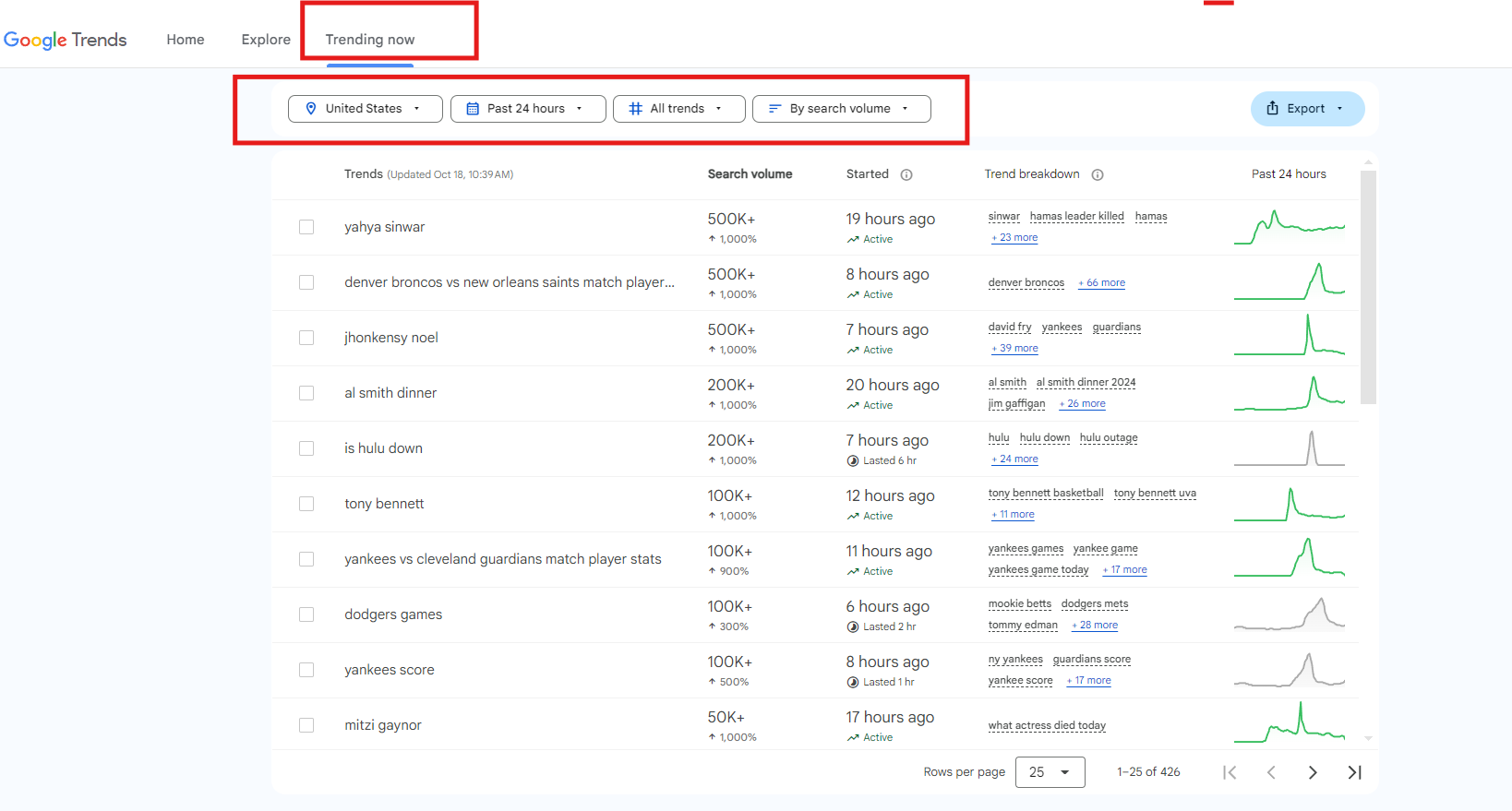
This gives you a chance to create timely blog posts, videos, or social media updates that grab attention.
Another pro tip: use the “Related Queries” feature in Google Trends. This can reveal ideas you may not have considered.
For example, if you’re selling fitness gear, searching for “Resistance Bands” might also show related trending searches like “Home Workouts” or “Bodyweight Exercises.”
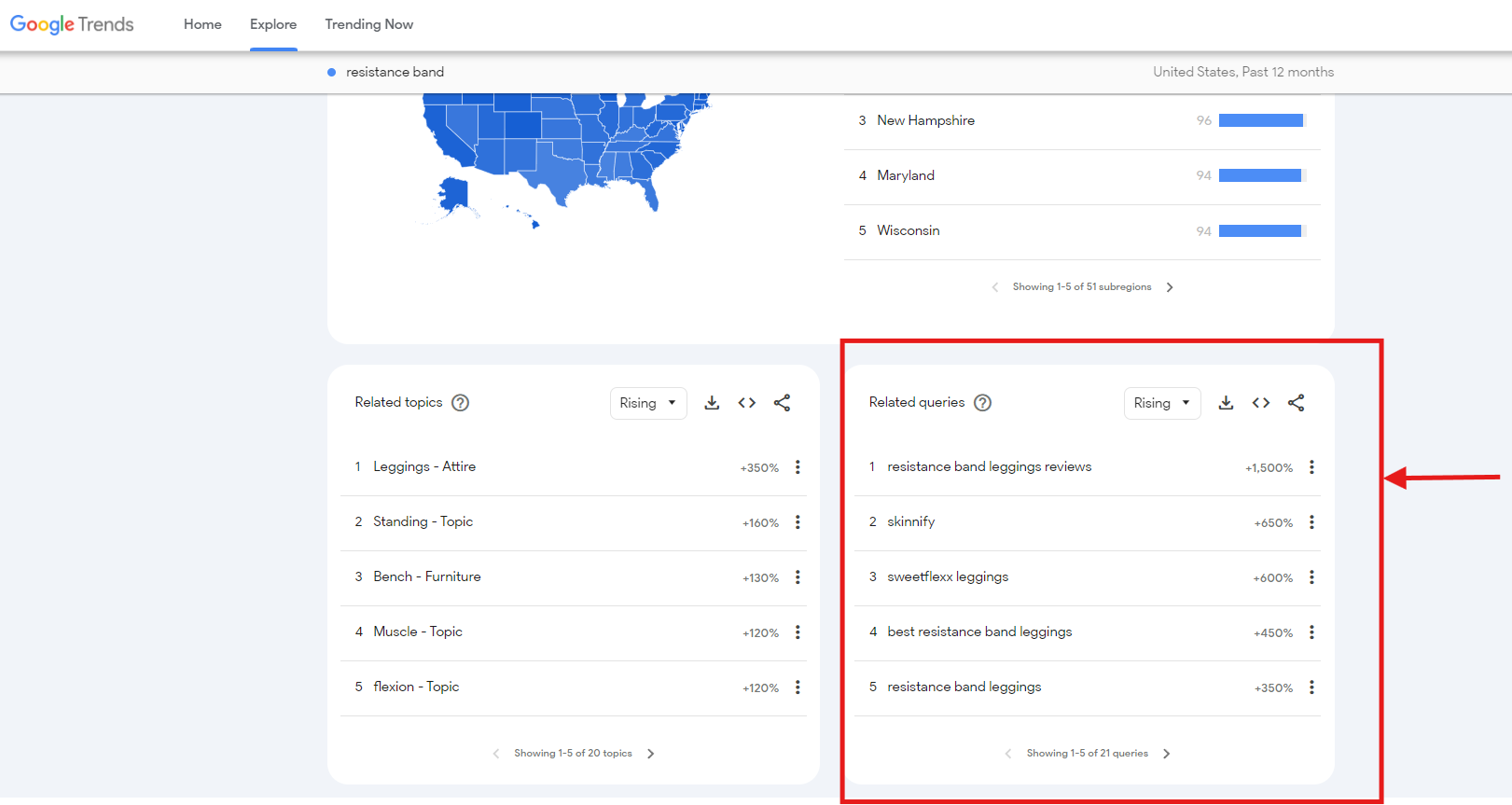
That’s a hint to create content or promotions around those topics!
8. Leveraging Seasonal Trends
If you want to maximize your sales during specific times of the year, Google Trends can be your best friend. It’s perfect for finding trending products during holidays or events.
For example, in the weeks leading up to Valentine’s Day, keywords like “Valentine’s Gifts” or “Romantic Getaways” spike.

Moreover, you can use this data to run special promotions, create themed content, and stock your store with seasonal products that are guaranteed to be in demand.
The key is to sell products that thrive during these times, and avoid anything with too low of a search volume—it’ll be tough to rank.
Think holiday-themed products like “Christmas Sweaters” or “Halloween Decorations.” Look for trends that peak during these seasons, then plan your inventory accordingly.
9. Boosting Your YouTube Reach
Here’s a trick not everyone knows: you can use Google Trends to optimize your YouTube content! By searching for trending topics on YouTube search on Google Trends, you can figure out what viewers are looking for.
For example, if you type “Travel Vlog” into Google Trends and filter for YouTube, you might discover that specific destinations like “Bali Travel Vlog” are on the rise.
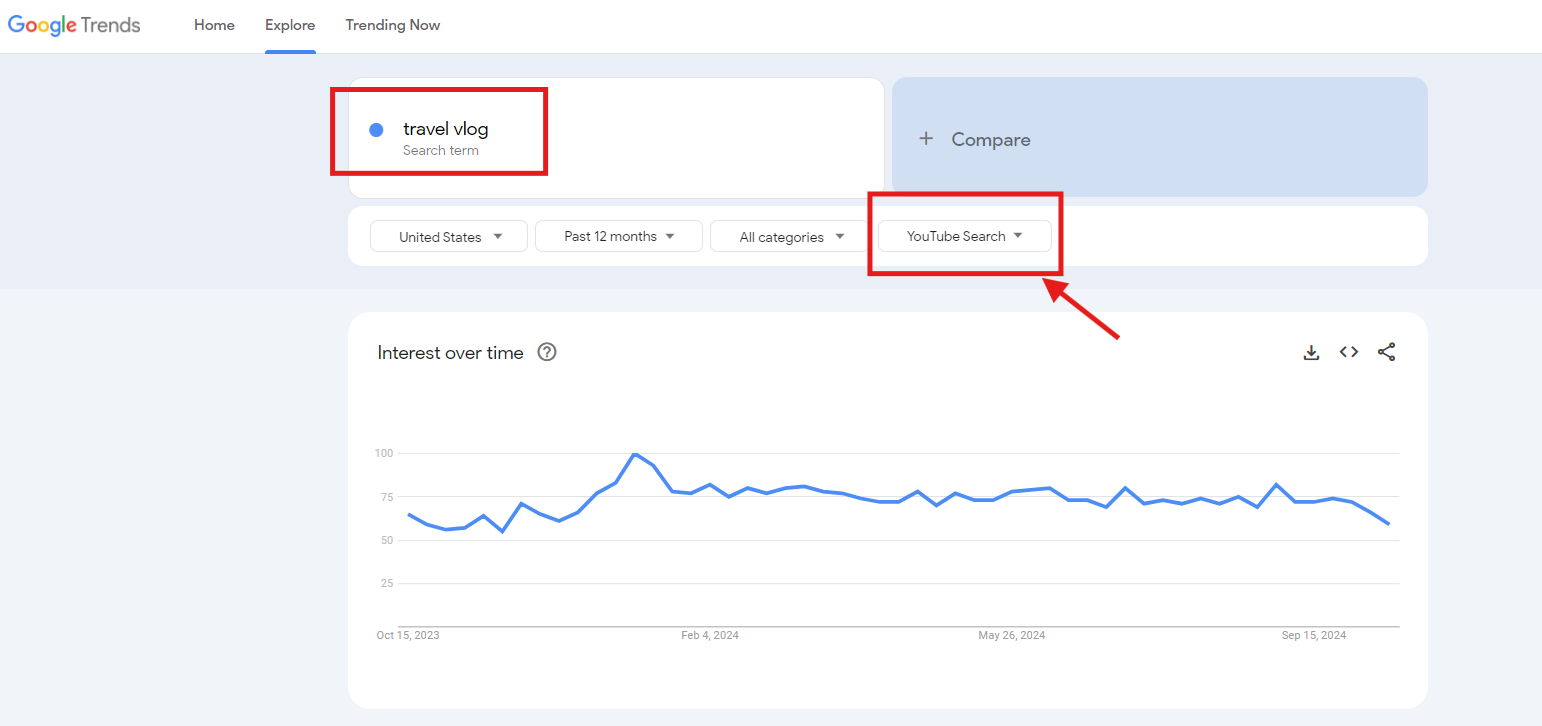
This insight allows you to create targeted videos that are more likely to gain views, comments, and shares—all crucial for higher YouTube rankings.
As a dropshipper, keep an eye on trending videos in your niche. Whether you’re selling beauty products or tech gadgets, creating content that aligns with current trends will help you drive traffic and grow your channel.
10. Google Shopping Insights
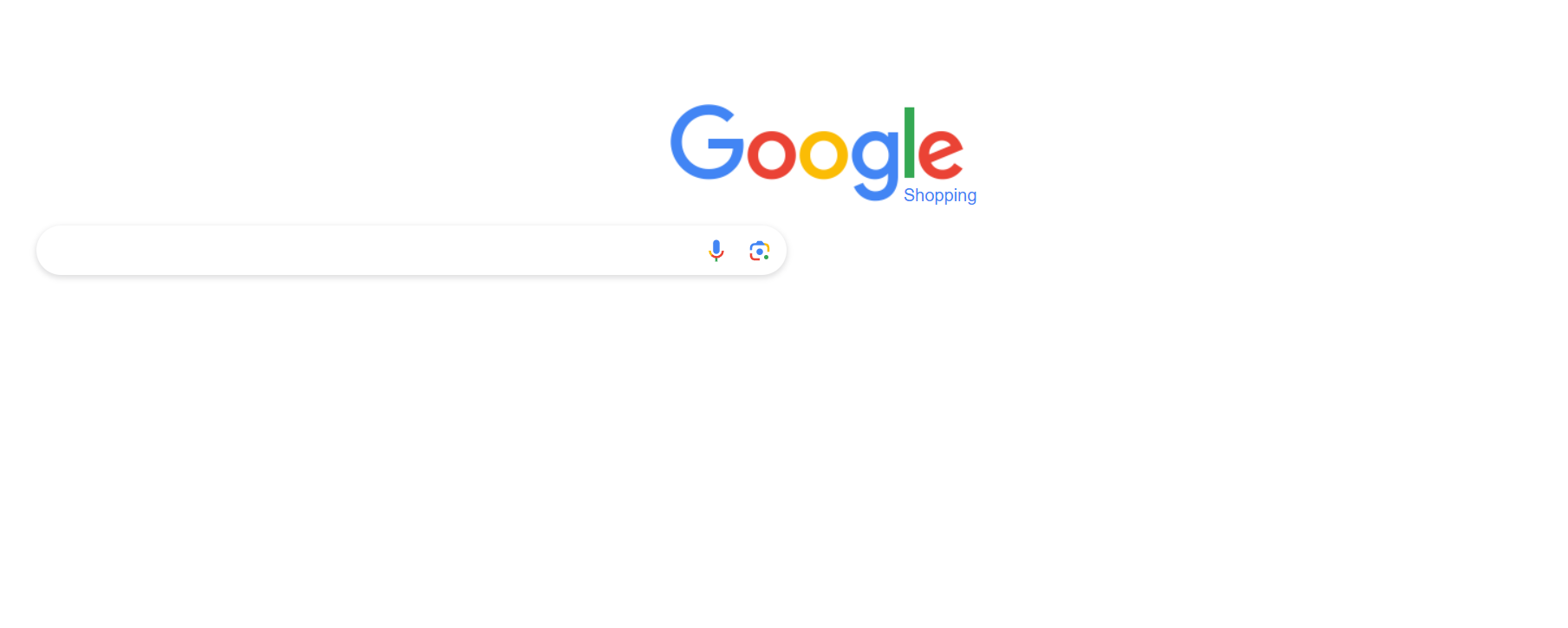
Google Shopping is another feature you shouldn’t overlook. You can check out what’s trending on Google Shopping to see which product categories are currently hot.
This is super useful for dropshippers because it gives you an idea of what products you might want to add to your store.
Let’s say you search for “Winter Jackets” around November—you’ll see a surge in related products like “Thermal Gloves” or “Snow Boots.” Use these insights to update your inventory and stay relevant.
In the end, the goal is to always keep your products in line with what’s trending in your target audience. Don’t miss out on the chance to spot trends early and ride the wave to more sales.
What To Keep In Mind When Using Google Trends?
 Consider Search Intent First
Consider Search Intent First
When using Google Trends for dropshipping, it’s important to think about search intent—understanding what people are actually looking for.
This helps you deliver better solutions. For example, during the pandemic, there was a massive surge in searches for items like hand sanitizers.
If you had been dropshipping at that time, you could have expanded your offerings to include related products like disinfectant wipes or face shields, capitalizing on the increased interest.

By grasping the reason behind certain search terms, you can find new opportunities to grow your store with high-demand products.
 Use Google Trends with Ahrefs
Use Google Trends with Ahrefs
While Google Trends is a powerful tool, it’s even more effective when combined with others.
For instance, if you’re trying to create an SEO blog for your store, Google Trends will show you trending keywords, but that’s only half the story.
To really nail down the right focus keyword, you can use Ahrefs to analyze the keyword’s difficulty and traffic potential.

This gives you a more comprehensive understanding of what will work best in your content. Combining both tools ensures your content is optimized to rank higher, ultimately driving more traffic to your online store.
In addition to these tools, don’t forget to check your store’s data and get feedback from your customers. If you’re just starting out, consider seeking advice from a mentor to help guide your dropshipping success.
 Pay Attention to Keyword Accuracy
Pay Attention to Keyword Accuracy
Accuracy is key when searching with Google Trends. Sometimes small changes in your search term can make a big difference.
For example, let’s say you’re researching solar-powered products. If you enter “solar-powered” with a hyphen, you might not find the data you need.
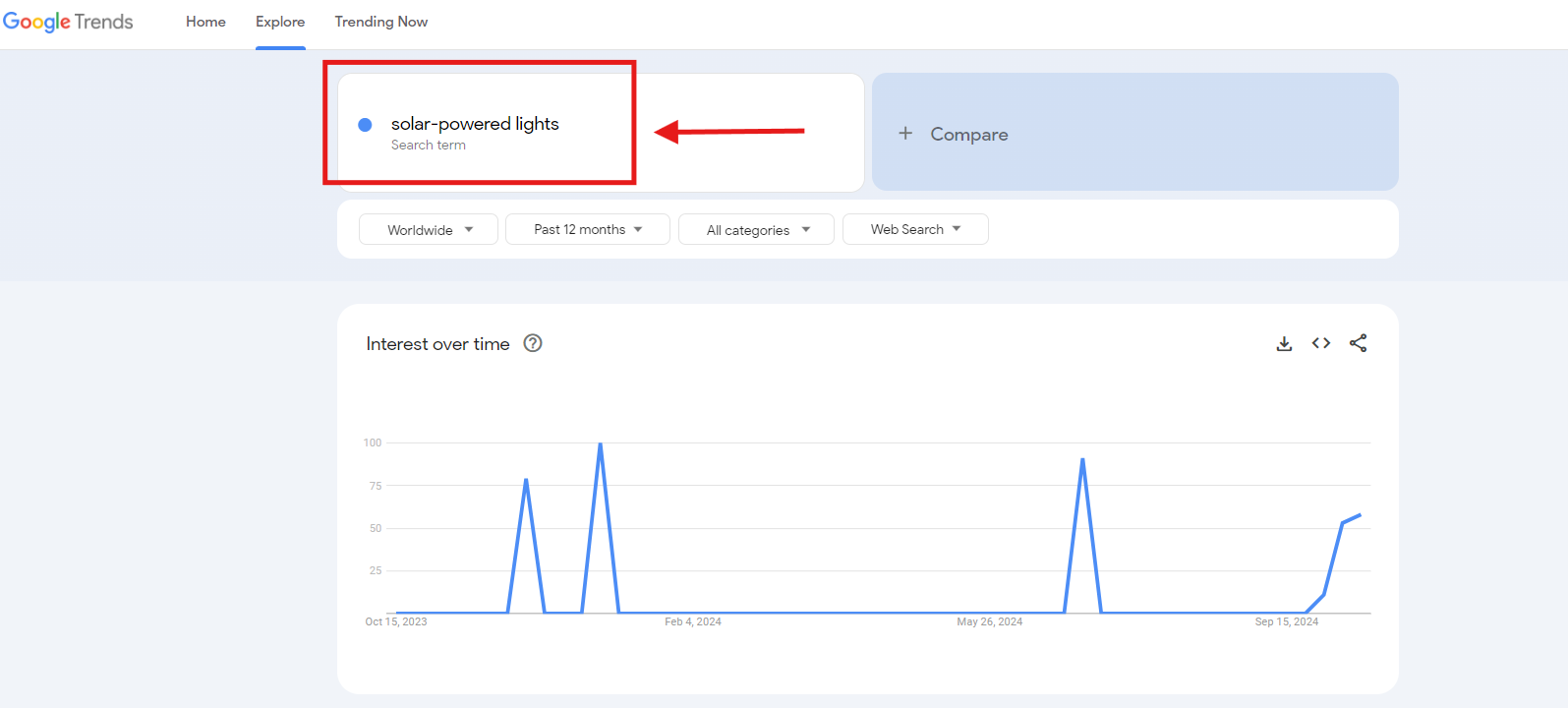
But if you change it to “solar powered” (no hyphen), you could unlock valuable insights about this trending niche. This is why you must be precise with your search terms to ensure you’re getting the right data.
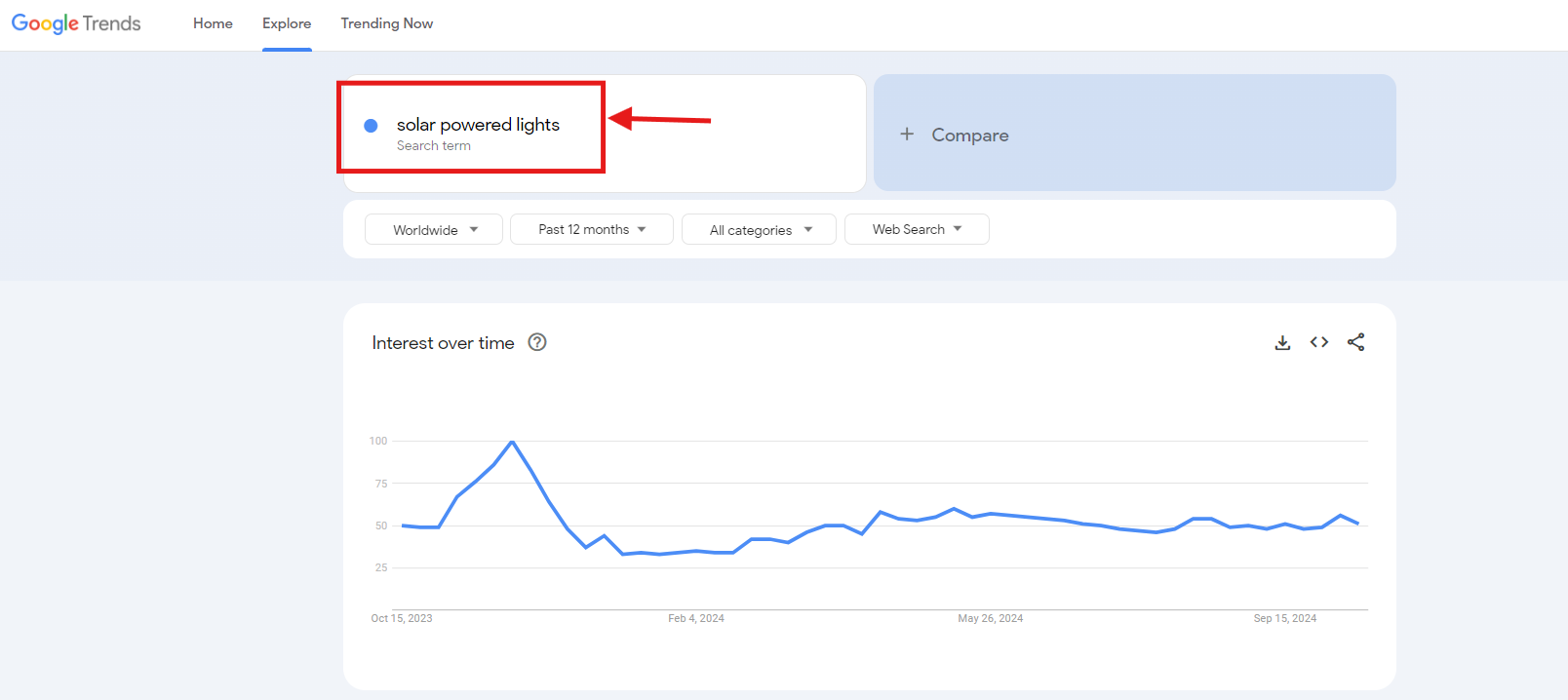
Experimenting with different versions of related keywords can help you discover trending topics and refine your strategy, especially when it comes to keyword searches that drive traffic to your store.
 Combine Google Trends with Other Tools for Better Insights
Combine Google Trends with Other Tools for Better Insights
Though Google Trends provides great insights into search interests and related topics, it’s always a good idea to use other tools alongside it.
For example, if you’re trying to decide whether to sell athletic wear, Google Trends can show you how much interest there is in sports bras.
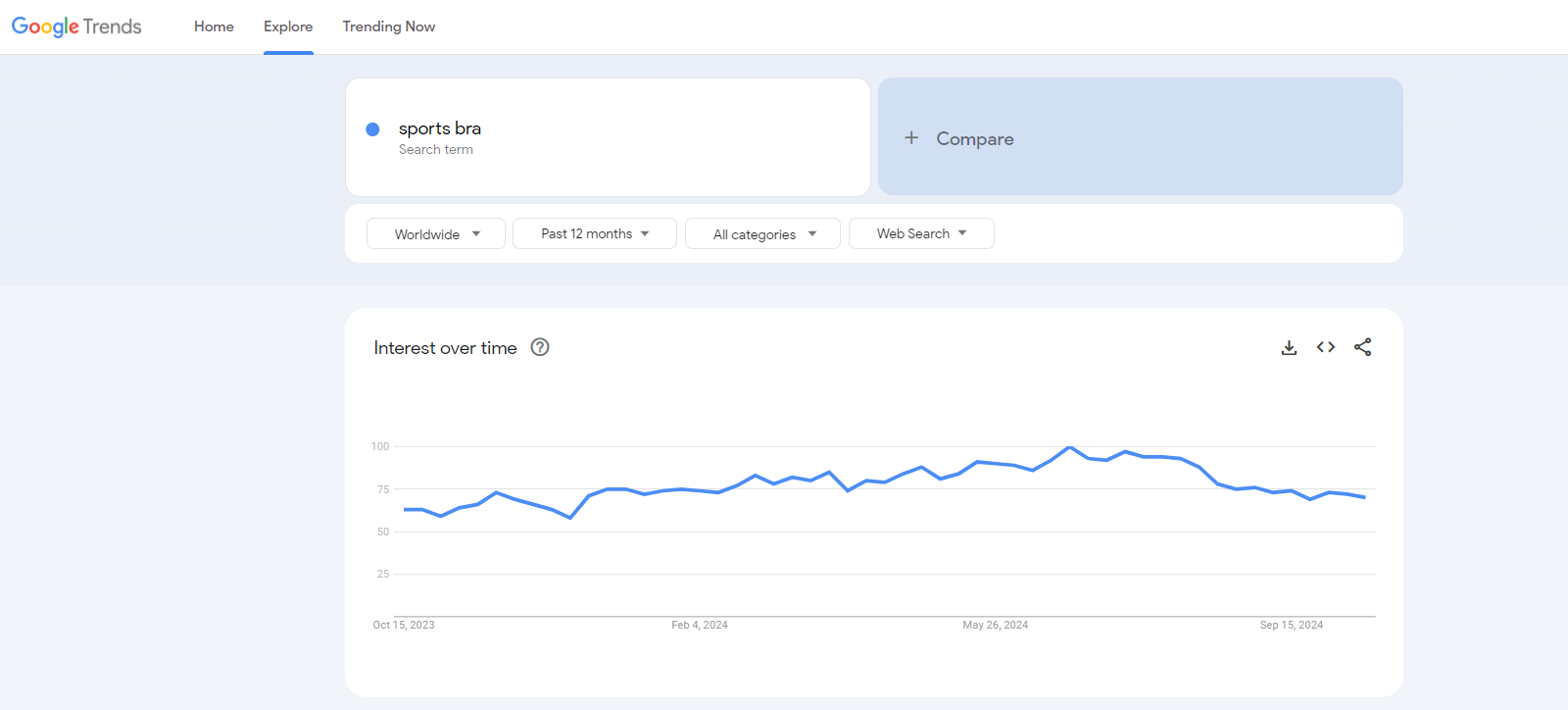
However, you might need to use tools like Google Ads or Google Analytics to get a deeper understanding of the market and your competition.
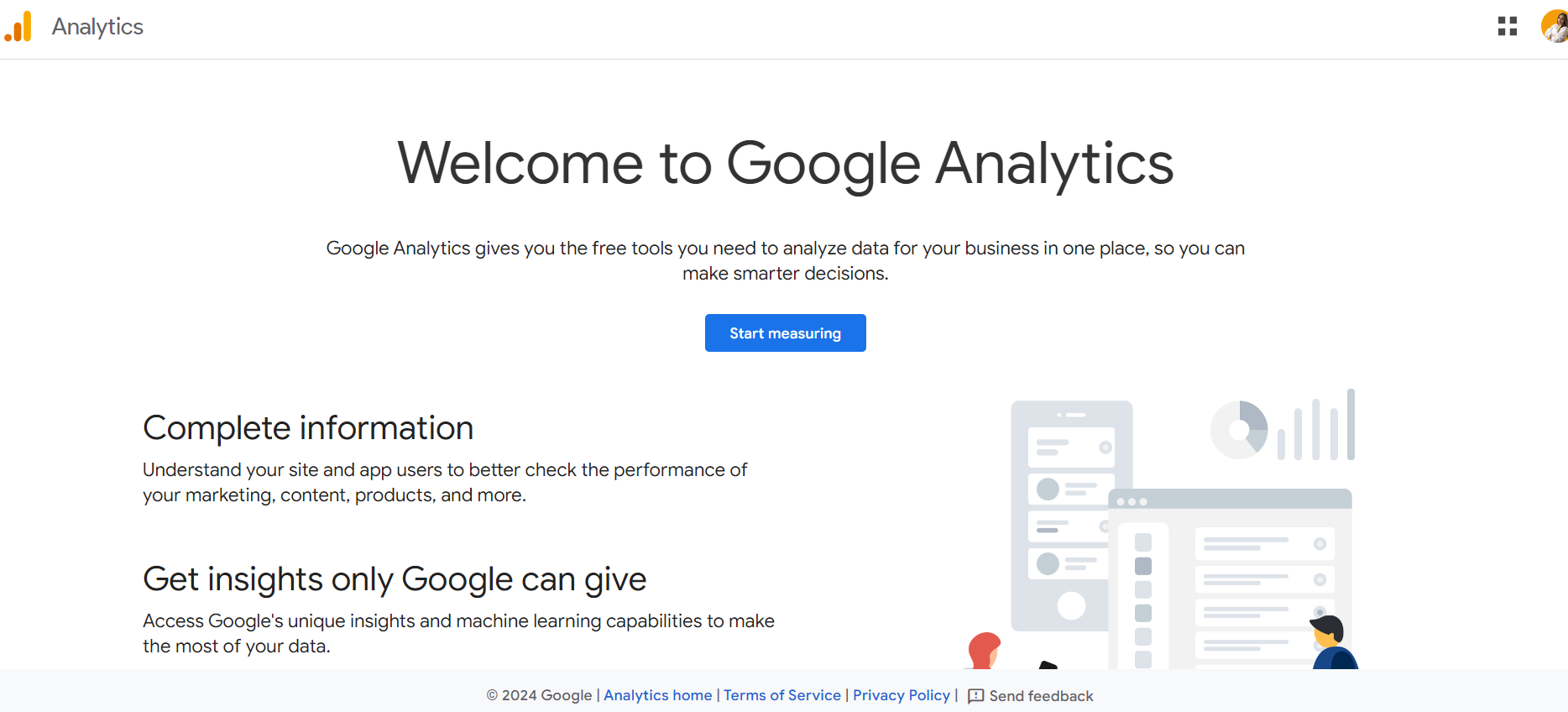
By combining these tools, you can gather valuable insights to improve your marketing efforts and boost your chances of creating a profitable dropshipping business.
Moreover, always back this up with feedback from your customers and real-time search trends to keep your business on the right path.
Google Trends Compared to Other Dropshipping Research Tools
Google Trends is an amazing tool for getting a bird’s-eye view of your industry. It helps you uncover trending products, spot popular keywords, and dive deep into consumer behavior.
But if you’re really serious about building a successful dropshipping business, you need to pair it with other tools to get more granular and specific data. Let’s break down how these tools stack up and how to combine them for the best results.
SEMrush – Keyword Research Powerhouse
While Google Trends gives you insight into search interest and trending topics, SEMrush digs deeper into the metrics that matter, like keyword difficulty, search volume, and the competitiveness of keywords.
It’s perfect for refining your SEO strategy and finding long-tail keywords that have the potential to convert.
Let’s say you’ve found that “drone” is trending on Google Trends. You can take that keyword to SEMrush, where you’ll get more precise data, like the cost-per-click (CPC) and how competitive the term is for paid search.
This helps you decide whether it’s worth investing in or if you should focus on a less competitive niche.
Although SEMrush can be pricey, it’s one of the best tools for market analysis if you’re serious about growing your online business through organic traffic.
Ahrefs – Comprehensive SEO Tool
If SEMrush is a keyword wizard, Ahrefs is your go-to for backlink analysis and detailed SEO insights.
You can use Google Trends to find related keywords, but Ahrefs allows you to see which of those keywords are actually driving search traffic to competitors.
It’s all about understanding not just what’s trending, but how people are getting to those trends.
Let’s say you found “sustainable fashion” is on the rise using Google Trends.
With Ahrefs, you can identify the top websites that are ranking for that keyword, then dig into their backlink profile to see how they’ve built authority.
This gives you a roadmap to replicate their strategy and build your own SEO success.
Google Trends is a great tool for finding trending products and popular keywords. It allows you to take a look at the big picture of your industry and market and identify general consumer behavior.
Use Google Trends In Combination With Product Research Tools
When it comes to finding what to sell, you can use one of the best dropshipping product research tools like Sell the Trend, Niche Scraper, Ecomhunt, etc.
For example, you can go to Google Trends first and check on product demand or interest over time. Next, you can open a product research tool and get more insight.
For example, Sell The Trend goes a step further by pinpointing winning products and giving you access to market data that helps you decide which products to add to your store.

Thus, you can get more detailed data on how well this product is performing on platforms like AliExpress and Amazon, plus insights into shipping times, pricing, and potential profit margins.
Check my full Niche Scraper Review.
Discover my full Ecomhunt Review.
Check out my full Sell The Trend Review.
Again, use one of these tools together with Google Trends for the best results.
Google Trends FAQs
1. What are the limitations of Google Trends when using it for dropshipping research?
Google Trends provides valuable insights into trends and the relative popularity of search terms, which is instrumental for dropshipping research.
However, its limitations stem from the lack of absolute search volume data reliance solely on Google search data. Moreover, a focus on search terms without delving into consumer intent.
These limitations can make it challenging for dropshippers. Hence, you cannot gauge the exact market size or understand the full scope of consumer behavior.
Consequently, Google Trends is a powerful tool for identifying trends. It should be used in conjunction with other market research methods to obtain a comprehensive view of the market.
2. How can one integrate Google Trends data with other analytics tools for a more comprehensive market analysis?
Integrating Google Trends with other analytics tools, such as SEMrush, Ahrefs, and social media analytics platforms, can significantly enhance market analysis.
This approach involves using Google Trends to spot emerging trends and then applying tools like SEMrush or Ahrefs for deeper keyword research, competitive analysis, and SEO planning.
Social media analytics can add another layer of insight into consumer sentiment and trends not yet captured by search data.
By cross-referencing and analyzing data from these various sources, dropshipping businesses can develop a more nuanced understanding of the market.
You can identify opportunities, and craft strategies that are informed by a broad spectrum of consumer behavior insights.
3. Are there specific case studies or success stories of dropshipping businesses that have significantly benefited from using Google Trends?
Numerous dropshipping entrepreneurs have shared benefits from Google Trends. They claim that the tool has been pivotal in identifying niche products and market opportunities before they became saturated.
Early identification of trends, such as an uptick in interest in eco-friendly products, and health supplements, enabled these entrepreneurs to position their dropshipping stores advantageously in the market.
Others have leveraged Google Trends to understand seasonal demand. It allows them to optimize inventory and marketing strategies in alignment with consumer interest peaks.
4. How do I use Google Trends on Shopify?
Google Trends can help you discover trending keywords and product ideas for your Shopify store.
First, go to Google Trends, type in keywords related to your products, and filter by country or time range to see how interest changes.
You can also compare keywords to choose the most popular. Then, integrate the keywords into your Shopify store’s SEO, product descriptions, and marketing campaigns to attract more customers.
5. Is dropshipping allowed on Google?
Yes, dropshipping is allowed on Google. You can use platforms like Google Ads to promote your products and drive traffic to your dropshipping store.
Additionally, you can leverage Google Shopping to list and advertise your products directly on the Google search engine.
6. How do I use Google Trends for beginners?
If you’re a beginner, start by visiting Google Trends and typing in a product or topic you’re interested in. You can filter the results by region, time, and category. Look for rising trends or consistent interest over time. Try comparing two different search terms to see which one is more popular. Use the data you gather to find profitable niches or products.
7. How do I find best selling products on Google Trends?
To find best-selling products on Google Trends, search for product-related keywords, then filter by location and time. Check the interest over time to see if the product is gaining popularity or if it’s seasonal. Look for products with a steady upward trend or significant interest spikes to identify potential best-sellers.
Conclusion
To summarize, Google Trends For Dropshipping is an invaluable tool that can provide key insights into market trends, product popularity, and regional demand.
By using it effectively, you can stay ahead of competitors and make data-driven decisions. However, before diving in, consider factors like seasonal trends, competition, and keyword accuracy.
My advice? Always cross-check Google Trends data with other research tools to get a full picture of your market.
With this approach, you’ll be better equipped to choose the right products and markets for success.
















![The Top 21 3PL Companies Compared [2025 List & Guide]](https://images.weserv.nl/?url=https://prod-dropshipping-s3.s3.fr-par.scw.cloud/2024/03/Frame-3922469.jpg&w=420&q=90&output=webp)